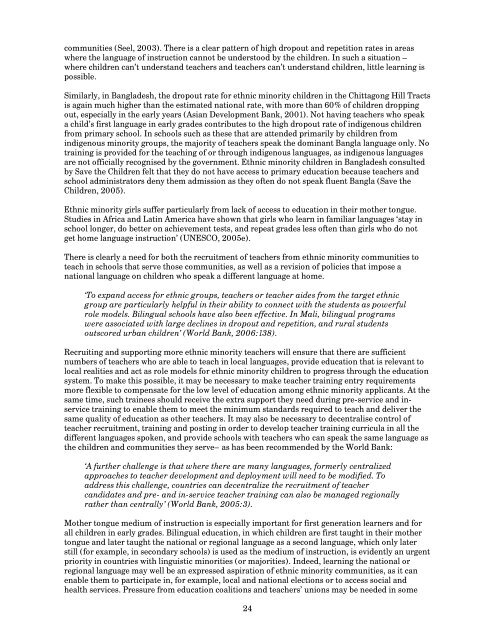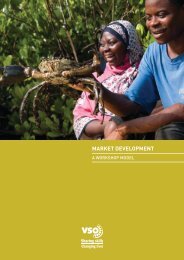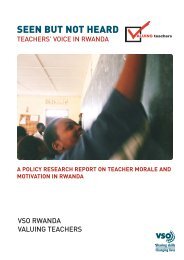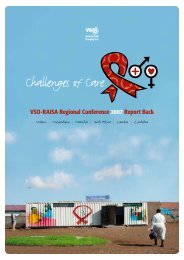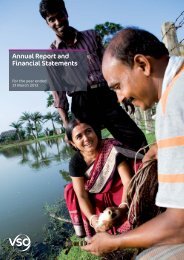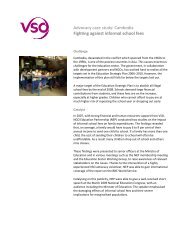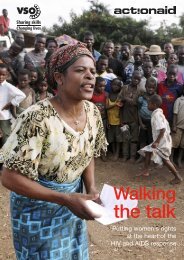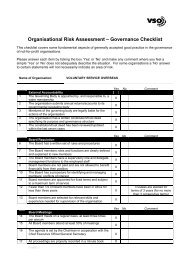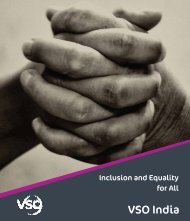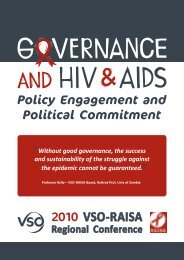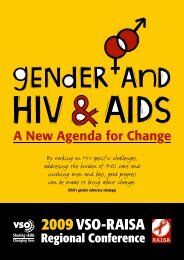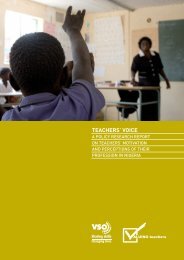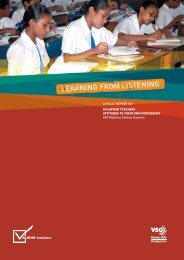Teachers for All â GCE policy briefing (566KB) - VSO
Teachers for All â GCE policy briefing (566KB) - VSO
Teachers for All â GCE policy briefing (566KB) - VSO
Create successful ePaper yourself
Turn your PDF publications into a flip-book with our unique Google optimized e-Paper software.
communities (Seel, 2003). There is a clear pattern of high dropout and repetition rates in areaswhere the language of instruction cannot be understood by the children. In such a situation –where children can’t understand teachers and teachers can’t understand children, little learning ispossible.Similarly, in Bangladesh, the dropout rate <strong>for</strong> ethnic minority children in the Chittagong Hill Tractsis again much higher than the estimated national rate, with more than 60% of children droppingout, especially in the early years (Asian Development Bank, 2001). Not having teachers who speaka child’s first language in early grades contributes to the high dropout rate of indigenous childrenfrom primary school. In schools such as these that are attended primarily by children fromindigenous minority groups, the majority of teachers speak the dominant Bangla language only. Notraining is provided <strong>for</strong> the teaching of or through indigenous languages, as indigenous languagesare not officially recognised by the government. Ethnic minority children in Bangladesh consultedby Save the Children felt that they do not have access to primary education because teachers andschool administrators deny them admission as they often do not speak fluent Bangla (Save theChildren, 2005).Ethnic minority girls suffer particularly from lack of access to education in their mother tongue.Studies in Africa and Latin America have shown that girls who learn in familiar languages ‘stay inschool longer, do better on achievement tests, and repeat grades less often than girls who do notget home language instruction’ (UNESCO, 2005e).There is clearly a need <strong>for</strong> both the recruitment of teachers from ethnic minority communities toteach in schools that serve those communities, as well as a revision of policies that impose anational language on children who speak a different language at home.‘To expand access <strong>for</strong> ethnic groups, teachers or teacher aides from the target ethnicgroup are particularly helpful in their ability to connect with the students as powerfulrole models. Bilingual schools have also been effective. In Mali, bilingual programswere associated with large declines in dropout and repetition, and rural studentsoutscored urban children’ (World Bank, 2006:138).Recruiting and supporting more ethnic minority teachers will ensure that there are sufficientnumbers of teachers who are able to teach in local languages, provide education that is relevant tolocal realities and act as role models <strong>for</strong> ethnic minority children to progress through the educationsystem. To make this possible, it may be necessary to make teacher training entry requirementsmore flexible to compensate <strong>for</strong> the low level of education among ethnic minority applicants. At thesame time, such trainees should receive the extra support they need during pre-service and inservicetraining to enable them to meet the minimum standards required to teach and deliver thesame quality of education as other teachers. It may also be necessary to decentralise control ofteacher recruitment, training and posting in order to develop teacher training curricula in all thedifferent languages spoken, and provide schools with teachers who can speak the same language asthe children and communities they serve– as has been recommended by the World Bank:‘A further challenge is that where there are many languages, <strong>for</strong>merly centralizedapproaches to teacher development and deployment will need to be modified. Toaddress this challenge, countries can decentralize the recruitment of teachercandidates and pre- and in-service teacher training can also be managed regionallyrather than centrally’ (World Bank, 2005:3).Mother tongue medium of instruction is especially important <strong>for</strong> first generation learners and <strong>for</strong>all children in early grades. Bilingual education, in which children are first taught in their mothertongue and later taught the national or regional language as a second language, which only laterstill (<strong>for</strong> example, in secondary schools) is used as the medium of instruction, is evidently an urgentpriority in countries with linguistic minorities (or majorities). Indeed, learning the national orregional language may well be an expressed aspiration of ethnic minority communities, as it canenable them to participate in, <strong>for</strong> example, local and national elections or to access social andhealth services. Pressure from education coalitions and teachers’ unions may be needed in some24


